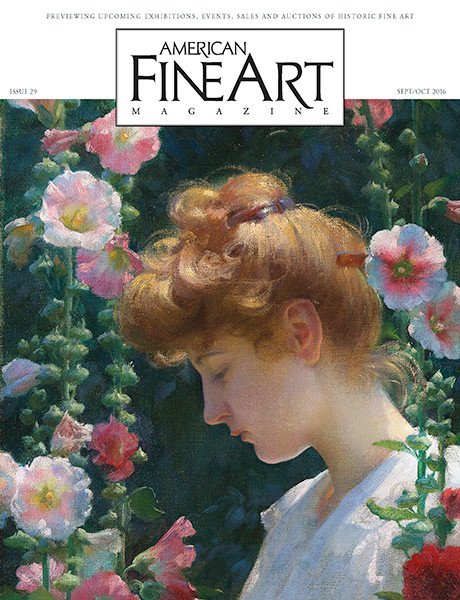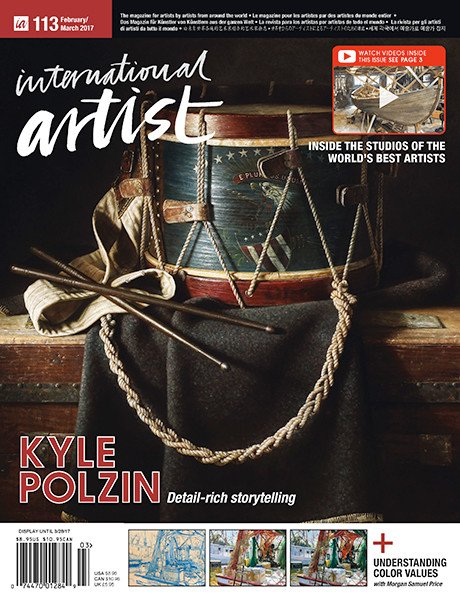Galeria ConTici
2572 Enterprise RoadOrange City, Fl 32763
386.227.7233
Email this Gallery
Visit Gallery Website
Galeria ConTici
11/9/2020 - 5/9/2021
Ai Apaec
Ca. 1 - 700 AD.
Atop of this copper tumi sits one of the most important deities in the Moche pantheon, the great god of creation - Ai Apaec. God of the sky and mountain. Precursor to the Inca god Viracocha. Superb detailed casting. Fearsome warrior god face with hair of snakes. Both arms and legs finials also detailed showing open mouth serpents. Verdigris patina throughout. Measures 7.5"/19 cm.
This piece is one of two being offered from a collection published in a large coffee table book called "Cobre del Antiguo Peru - The Copper of Ancient Peru". Highly sought by specialist and collectors alike. pp. 370 and 371; plate 52/53/54.

Chancay Kupulwe Litter
Ca. 900-1400 A.D.
Finely made Chancay kupulwe/Cradle board. Laid upon a bed of reed slats, a solid clay figure is nicely wrapped using a cotton textile blanket, secured with string. Carved spool type finals on wood beams. Coarse human hair is braided, intertwined between cross-members to assemble the platform. A substantial amount of personal care has been given in its construction. Measures 12.5"/31,75cm in height un-mounted. 13.25”/33,65cm with custom metal stand.

Guanacaste-Nicoya Axe God Pendant
Ca. 500 B.C. - 500 A.D.
Carved in low relief with highly polished front. Linear incising for all facial features. Hands uniting across upper chest. Rear shows flat sawed surface, partly smoothed and broken septum. Sharp bottom edge. Finally, there are two drilled holes on each side of the head through which this object could be suspended and worn. Black Jadeite with deeply embedded earthen deposits creates this brown coloring. H. 4.75” tall. Choice condition. Guanacaste-Nicoya region, Costa Rica.

Hauri/Chancay Mummy Mask
Ca. 900 - 1250 A.D.
5.25 x 4.25 x 3 inches (L x W x D)
Nicely carved smaller false mummy mask. Painted overall in red cinnabar or iron oxide. Facial features are in relief. Eyes are incised white with black pupils. Four cutouts behind outer mask used in original suspension. Custom base included.
Measures 5.25"/13.33 cm in height, 4.25"/10.79 cm. in width.
7.5" overall height on stand.
West coast, Peru. ca. 900 - 1250 AD.

Inca Quipu
Ca. 14th - 16th c.
The Andean corded communication system. The cord’s composition, ply, length, end treatment, and color were all significant factors in the quipu’s use and meaning.
This enigma is made of Cotton. Composed of a thicker, 32"/81.28 cm long Primary cord. It contains 65 pedant cords alternating in segmented tan and brown colors. Each pendant varies in length with strategically placed differing type knots representing numeric values. According to Harvard University's Quipu Data Base Project, there are approximately 600 Quipus in existence in museum, university and private collections around the world.

Inca Shepherd’s Sling
Ca. 14th - 16th c.
This herding sling is made of colorful braided Llama wool. Large tassel at one end used to swing and persuade their herd. The center slotted pouch cradled the projectile (smaller than a warriors sling). There are other slings used by the Incas. A Warriors sling has a large center pouch without having a tassel. The ceremonial dance huaraca is elaborate in its construction. Resembles this Shepherd sling but usually lacks the pouch slit.
Andean highlands, Peru. Ca. 16th -17th century. Measures 60" / 152.4 cm in length. Choice condition. Attached Museum de-accession Label.

Mayan Jade Face Plaque Pendant
Ca. 550 - 900 A.D.
Maya Jade Face Plaque Pendant of a Lord or Warrior. Trapezoid in shape. Carved in low relief with polished front. Rear is flat with laterally perforations on upper portion for suspension. Olive green Jadeite with light brown inclusions. H. 2” tall. Very nice example. Mayan territories, ca 550 - 900 A.D.

Mezcala Axe God Stone Figure
Ca 700 B.C. - 650 A.D.
A symmetric Mezcala anthropomorphic Axe God figure. Type M-8. Carved from gray Metadiorite stone. Incised features and details indicated by grooving. A fine and very attractive semi- abstract piece. Sediment deposits throughout as found. Guerrero, Mexico. Measures: H. 7.625”/19.37 cm.

Michoacan Effigy Vessel
Ca. 100 B.C. - 250 A.D.
An excellent globular effigy vessel from the Michoacan culture, Mexico. Ca. 100 B.C. - 250 A.D. Stands over 10" in height. Cream paint over highly burnished red slip. A sweet rectangular face on extended rim with arms painted in front. An additional representation of a bird with outstretched wings in reverse on sides. Ample dendrites and mineral deposits throughout.
Comparable example is published in The Teuchitlan Tradition and a similar pot is owned by the American Museum of Natural History albeit without the superior quality and size possessed by this Galeria Contici vessel.
Condition: Choice

Moche Seated Bound Prisoner
Mochica III 200-300 A.D.
An extraordinarily and expressive wooden Moche III seated bound prisoner. Uniquely made from a piece of the Aphandra (mastodon palm) tree into a human Calero (lime container). His facial features are exaggerated and remarkable. Almond shaped eyes, made of shell with purple spondylus pupils. Large nose, ears and pointed head. Curled copper wired whiskers are also attached to his face and nacre (mother of pearl) applied all around the neckline. Unclothed with hands bound by rope behind his back. Head is removable which exposes the attached copper spatula and hollowed out lower body. The fearsome Moche capture their enemy and humiliated them by removing their clothing, parading them prior to sacrifice. Removal of his head could symbolize the tribute of taking a trophy head.
Size: 4"/10.16cm Unmounted - 6.25"/15.87cm Mounted.
An outstanding piece of art history in wood rarely seen in an exceptional state of preservation and subject matter.

Nariño Vessel
Ca. 750 A.D.-1250 A.D.
18.5 x 13 x 13 inches (L x W x D)
Very large globular vessel from the Piartal cultural complex. Ca. 750 A.D.-1250 A.D. Highland Nariño region. This rare important olla is decorated with symbols of authority. Resist black painted curved canes and spot elements integrated onto the cream painted pot with added red and black framing lines. Measures approx 18.5" H, 13" Dia., 44" circum.
Completely intact with minor surface wear consistent with its age - Strong paint. Condition is Choice.

Nicoya Choker
Ca. 100 B.C. - 500 A.D.
A gorgeous colorful short choker from Costa Rica. Centered light colored tube stone surrounded by six Tigrillo canines on both sides (twelve in all). All separated by green Jadeite stones and brilliant orange Spondylus shells. Re-strung to an approximate 14”/35.56 cm. Largest canines is 1.25”/2.92 cm. Cost Rica 100 BC - 500 AD.

Olmec Were-Jaguar Mask
Ca. 900-600 B.C.
5.25 x 4 x 2.25 inches (L x W x D)
This exceptional were-jaguar mask was sculptured from the Olmec’s most favored jade stone. Ranging 7 on the Mohs hardness scale, this masterful creation was extremely difficult to produce. The mask is unique and considered to be a shaman in the midst of transformation. Exhibits both animal and human qualities in high relief. Notable for its characteristic upraised upper lip, bifurcated tongue, curved fangs and cleft forehead. Perforated almond shape crossed eyes (strabismus), pug nose and projecting thin elongated ears. Two pierced holes for suspension.
Mexico, ca. 900-600 B.C. Very Rare mask in Jade - Investment piece.
Measures: 5.25”/13.33 cm H; 4”/10.16 cm W; 2.25”/5.71 cm D.; Over 7.25”/18.41 cm on custom upward projected metal stand.
Polished face with partly smooth back. No fractures. Completely intact in choice condition.
Provenance: L. Smyth, Florida. Acquired 1970s - 80s.
Accompanied by a hardbound CIRAM Scientific Analysts attesting to its authenticity and Ruffner Art Advisory Fair Market Value report.




